 A Ruse of Shadows (Lady Sherlock, #8) by Sherry Thomas
A Ruse of Shadows (Lady Sherlock, #8) by Sherry Thomas Format: eARC
Source: supplied by publisher via Edelweiss
Formats available: paperback, ebook, audiobook
Genres: historical fiction, historical mystery
Series: Lady Sherlock #8
Pages: 368
Published by Berkley on June 25, 2024
Purchasing Info: Author's Website, Publisher's Website, Amazon, Barnes & Noble, Kobo, Bookshop.org, Better World Books
Goodreads
Charlotte Holmes is accustomed to solving crimes, not being accused of them, but she finds herself in a dreadfully precarious position as the bestselling Lady Sherlock series continues.
Charlotte’s success on the RMS Provence has afforded her a certain measure of time and assurance. Taking advantage of that, she has been busy, plotting to prise the man her sister loves from Moriarty’s iron grip.
Disruption, however, comes from an unexpected quarter. Lord Bancroft Ashburton, disgraced and imprisoned as a result of Charlotte’s prior investigations, nevertheless manages to press Charlotte into service: Underwood, his most loyal henchman, is missing and Lord Bancroft wants Charlotte to find Underwood, dead or alive.
But then Lord Bancroft himself turns up dead and Charlotte, more than anyone else, meets the trifecta criteria of motive, means, and opportunity. Never mind rescuing anyone else, with the law breathing down her neck, can Charlotte save herself from prosecution for murder?
My Review:
A Ruse of Shadows is a fascinating study in contradictions. It’s a story about paying it forward, payback, and revenge served ice cold. It’s a yarn spun out of a tissue of lies and a truth that literally sets several people free. All the while it’s a game of three-handed chess that only one player understands is being played in 3D while both of the other players assume it’s being played in only two – and who consequently suffer the fate of those who assume.
This eighth entry in the Lady Sherlock series is also a bit of a caper story, as it begins, not at the beginning, but rather at what at first seems to be the end. Charlotte being in the midst of being questioned by the police in regards to the death of Lord Bancroft Ashburton in the immediate aftermath of his escape from the prison to which he had been remanded after his perfidy and treason were unveiled – by Charlotte and her friends – in the previous book in the series, A Tempest at Sea.
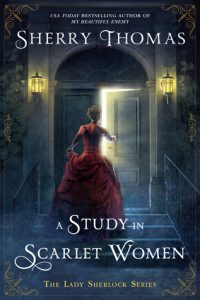 (This is a hint, by the way. Theoretically the books in this series could be read as standalone, but I wouldn’t recommend it. It’s not just that the endings of each book flow into the next, but that there’s a vast, interconnected and rather sticky web between all of the cases – at least so far. I’m glad I began at the beginning with A Study in Scarlet Women – and I think many readers are or will be as well.)
(This is a hint, by the way. Theoretically the books in this series could be read as standalone, but I wouldn’t recommend it. It’s not just that the endings of each book flow into the next, but that there’s a vast, interconnected and rather sticky web between all of the cases – at least so far. I’m glad I began at the beginning with A Study in Scarlet Women – and I think many readers are or will be as well.)
What makes the plot of this particular entry in the series so sticky – and so convoluted – is that it seems as though every past case is tied into this present one – particularly the most recent pair, Miss Moriarty, I Presume? and A Tempest at Sea.
It’s those cases that give Charlotte her motives for both facilitating Bancroft’s escape AND murdering the man – at least in the minds of the police investigators.
But Charlotte has a bland, banal and utterly blameless answer for every single one of their questions – at least on the surface. While she relates the story that she has prepared, the reader, however, is presented with the truth behind that fiction and the story switches between Charlotte’s innocuous tale and a vast and far-reaching plot of much more interesting but considerably less innocent truths.
Along with a few switches in perspective from Charlotte’s part of the story to accounts by some of her other agents in her grand plan to thwart Bancroft’s and Moriarty’s equally grand plots to trap her and her friends – one way or another.
Each of her enemies believes that they have her – and their counterpart – firmly within their grasp. The police believe that they have her “dead to rights” as well. But, particularly when it comes to outsmarting ‘Sherlock’ Holmes their beliefs don’t hold a candle to Holmes’ strategies, their intelligence, or the vast circle of friends and even frenemies willing to help them against any forces arrayed against them.
 Escape Rating B+: I have consistently found this series to be fascinating and frustrating in equal measure – and this entry in the series is no exception.
Escape Rating B+: I have consistently found this series to be fascinating and frustrating in equal measure – and this entry in the series is no exception.
On the one hand, as Bancroft, Moriarty and the police in the persons of Inspector Treadles and Chief Inspector Talbot all know that Charlotte is Sherlock is Charlotte, she doesn’t need to pretend to consult a fictitious brother – which certainly removes one of my chief sources of consternation with the series.
Charlotte does, however, make plenty of use of both male and female disguises – but then so did the original Sherlock. She has little need to protect her own supposedly delicate femininity – but is forced to kowtow to society’s restrictions and assumptions on behalf of some of the other women involved in the case. Still, it makes the story considerably less frustrating for the reader as Charlotte is finally able to just get on with the case by the employment of a suitable change of face and costume.
Howsomever, the way that this story is told, with its framing story of Charlotte pretending innocence to Chief Inspector Talbot while telling the reader the truth behind her bland answers – does occasionally get more than a bit muddled, a muddling that is not helped by the additions of Olivia’s point of view as Olivia’s part of this charade isn’t revealed until the end.
Which, admittedly, was exactly as it should have been, as Olivia is the chronicler of her sister’s cases.
 This story is also a bit of a mirror image to Miss Moriarty, I Presume? in that this time around it’s Lord Bancroft Ashburton (the disgraced former Mycroft after the events of A Tempest at Sea) who holds Charlotte’s hostages to fortune even as he attempts to maneuver Charlotte and her friends into a trap with the more-than-willing assistance of Moriarty. Her enemies are not friends, but are willing to collude with each other to get her, as she’s been a consistent thorn in both their sides.
This story is also a bit of a mirror image to Miss Moriarty, I Presume? in that this time around it’s Lord Bancroft Ashburton (the disgraced former Mycroft after the events of A Tempest at Sea) who holds Charlotte’s hostages to fortune even as he attempts to maneuver Charlotte and her friends into a trap with the more-than-willing assistance of Moriarty. Her enemies are not friends, but are willing to collude with each other to get her, as she’s been a consistent thorn in both their sides.
The case itself, as we finally get the full picture – was every bit as twisty and convoluted and purely confounding and compelling as this reader has come to expect in this series. At the very same time the corkscrews that those twists have turned themselves into feel like they’ve been winding and tangling since the very first book in the series – only because some of them have.
In the end, I found the case fascinating, even though the way the story got told felt like a bit of a muddle, particularly at the beginning. But when it came to the reveal at the end, the whole thing wrapped up marvelously and even though we’d seen most of how Charlotte got there she still had plenty of secrets left to uncover at the finish.
A finish which doesn’t remotely feel like an end to the series. I’m not sure what Charlotte and Company will be up to next – but I can’t wait to find out!

 A Tempest at Sea (Lady Sherlock #7) by
A Tempest at Sea (Lady Sherlock #7) by 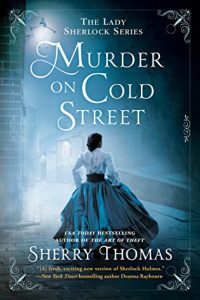 Because the detective who just so happens to be aboard the Provence is none other than the intelligent and implacable Inspector Brighton, a Scotland Yard CID investigator that Holmes got the better of – read as exposed that the Inspector’s implacability had sent him barking up the wrong suspect tree – in
Because the detective who just so happens to be aboard the Provence is none other than the intelligent and implacable Inspector Brighton, a Scotland Yard CID investigator that Holmes got the better of – read as exposed that the Inspector’s implacability had sent him barking up the wrong suspect tree – in 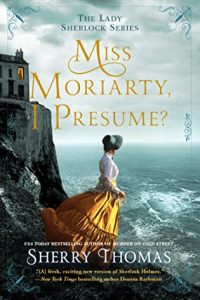 That niggle aside, the mystery was still fascinating. I loved watching Charlotte work while hiding behind the kind of character masking that the original Holmes did so well – instead of hiding behind Sherlock Holmes himself.
That niggle aside, the mystery was still fascinating. I loved watching Charlotte work while hiding behind the kind of character masking that the original Holmes did so well – instead of hiding behind Sherlock Holmes himself.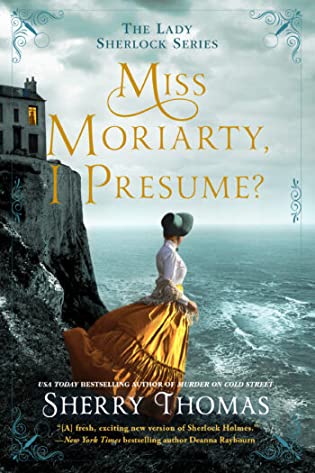 Miss Moriarty, I Presume? (Lady Sherlock, #6) by
Miss Moriarty, I Presume? (Lady Sherlock, #6) by 
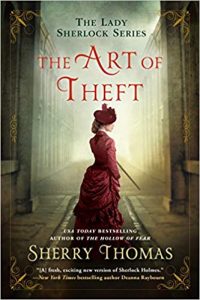
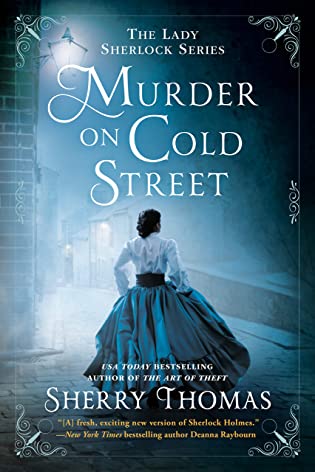 Murder on Cold Street (Lady Sherlock, #5) by
Murder on Cold Street (Lady Sherlock, #5) by  The Art of Theft (Lady Sherlock, #4) by
The Art of Theft (Lady Sherlock, #4) by 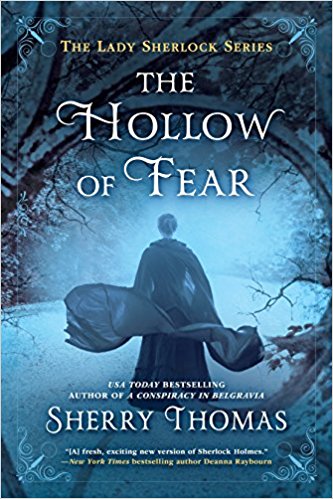 The Hollow of Fear (Lady Sherlock, #3) by
The Hollow of Fear (Lady Sherlock, #3) by 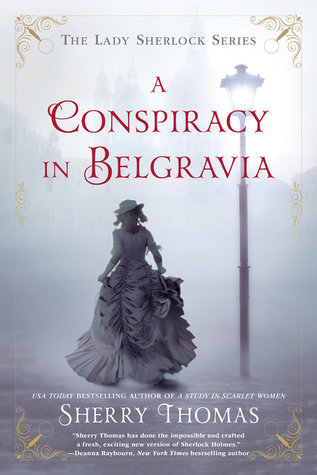 A Conspiracy in Belgravia (Lady Sherlock, #2) by
A Conspiracy in Belgravia (Lady Sherlock, #2) by 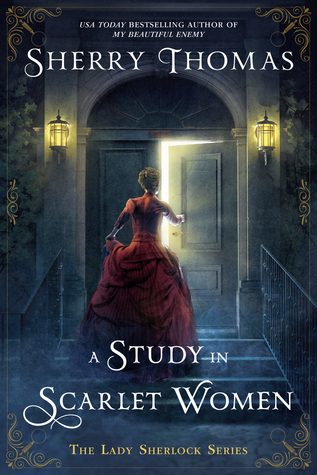 A Study in Scarlet Women (Lady Sherlock, #1) by
A Study in Scarlet Women (Lady Sherlock, #1) by